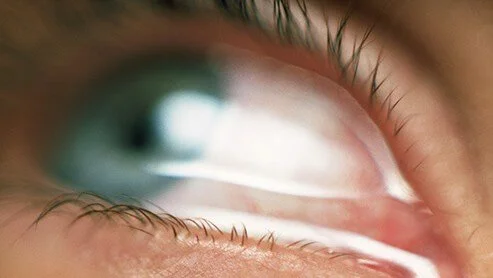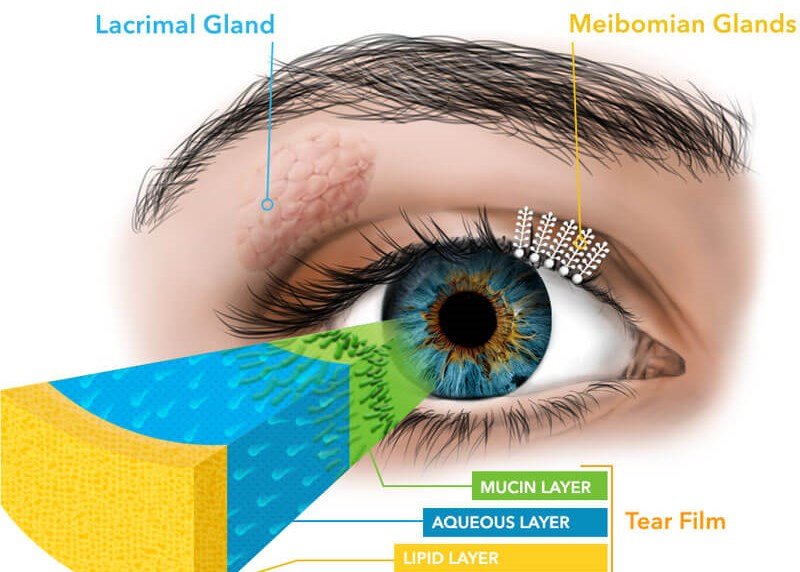What is Dry Eye Disease and is There a Cure?
The ocular surface includes several different structures in the eye, including the cornea (surface of the eye), conjunctiva (a thin tissue that covers the inside of the eyelids and white part of the eye), eyelids, and lacrimal glands (structure that produces the watery part of the tears). Whenever there is a disorder of any one of these structures,ocular surface disease (OSD) occurs. The most common type of OSD is dry eye disease (DED). DED occurs when the body does not produce an adequate amount of tears to keep the surface of the eye hydrated. This can mean the body either under-produces or over-produces the amount of tears necessary to keep the eye lubricated.
What are tears, and why do we need them anyway?
Tears are made up of three layers: a watery (aqueous) layer, an oily (lipid) layer, and a mucous-like (mucin) layer. Each layer of the tear film has a purpose. Lipids help keep the tear film from evaporating too quickly to allow the tears to sit on the surface of the eye for an adequate period of time. Mucin helps spread the tears across the surface of the eye. In a normally functioning eye, tears spread across the surface of the eye with each blink. When any of these layers are inadequate, the quality and/or quantity of tears may be impacted. Tears have many functions: they keep the eye lubricated, minimize infection, and keep the surface of the eye clear.
Are my eyes dry? How would I know?
Without adequate tear production, patients may experience several uncomfortable symptoms.
Besides a generalized feeling of dryness, there are many indicators that point to DED as a culprit. Individuals with DED often describe a stinging, burning, or scratchy sensation. Eyes may be aching, red, or fatigued. Wearing contact lenses, or prolonged computer work may be challenging. Vision may be blurry and activities like driving or watching television become more difficult. While it seems counterintuitive, watery eyes are often a sign of DED. The body senses that the eyes are dry, which causes an overproduction of tears. Because of this overabundance of tears, they often spill over before they have a chance to drain into the tear ducts, causing dripping or watering eyes.
There are a number of factors that increase the risk of DED. The risk of DED increases with age. Due to hormonal changes, women are often more likely to suffer from DED. Certain medications, such as antihistamines, decongestants, and blood pressure medications, can reduce tear production. Medical conditions associated with inflammation, such as diabetes, thyroid issues, or rheumatoid arthritis can increase the chance of DED. Environmental conditions, such as dry climates or exposure to smoke can increase this risk as well. Individuals who have had LASIK or other corneal surgeries have an increased risk of developing DED.
If you believe you have dry eyes, it is important to see your regular eye care provider. Optometrists and ophthalmologists often work together to treat patients who have DED. During an office visit, your doctor uses a special microscope with a light called a slit lamp to look at the surface of your eye and the surrounding structures. Based on the appearance of your eye, your doctor will diagnose DED if appropriate.
Can DED be cured?
Often, treatment of DED is focused on controlling discomfort and attempting to restore the balance of the tear film. There are several things that can be done at home to help prevent or decrease the discomfort of DED. Taking frequent breaks when reading, watching television, or using the computer are important. Keep in mind the 20-20-20 rule. Every 20 minutes or so, take a 20-second break, and blink about 20 times. While blinking is a reflex, it can be delayed while we are focused on other tasks. Keeping your environment humidified and avoiding fans or blowing air can help with symptoms. Staying well hydrated and taking a high-quality Omega-3 supplement can help increase the quality of tears. (We at ART Vision love PRN brand Omega-3s and those can be found here https://artvisionsf.myeyestore.com/)
Often, the first step in addressing DED is adding in preservative-free artificial tears 4-6 times a day. Over-the-counter nighttime gel ointments can be utilized if the eyes tend to become dry overnight. If the oil-producing glands around the eye are not performing adequately, warm compresses and eyelid massage may help the oil flow out of those glands more easily. The use of specialized eyelid cleansers can also keep the oil glands healthy and free from debris and bacteria. More aggressive options, such as punctual plugs (tiny devices that block the drainage of tears), prescription drops, ointments, or autologous serum tears, should be discussed with your eye care provider.
It is estimated the 5 million Americans over the age of 50 suffer from dry eye symptoms. DED can range in severity from annoying symptoms to severe difficulties with vision. The good news is, that by working together with your eye care provider, you can find some relief from symptoms associated with dry eye disease.


